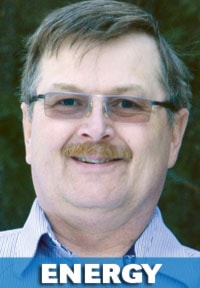Gravity is something we all are very familiar with.
We learned of its harsh consequences as toddlers learning to become mobile and growing up we suffered skinned knees, and possibly, even broken bones.
We appreciate gravity for keeping us tethered to the planet, but we suffer its influence as we try to walk or bike up a hill.
Somehow, over the generations, we have learned to harness this invisible but ever present force.
Water wheels powering grain or textile mills, and the ever popular hydroelectric dam projects are examples that spring to mind. Granted using water to store energy that can be converted to electricity is a brilliant concept, it does however present some major obstacles.
Environmental impacts on the flooded area, loss of arable land, keeping the resulting reservoirs free from silt, and the turbine intake free from debris are all serious concerns.
A new concept for energy storage is being developed that uses the potential energy of a hill, using gravity to provide kinetic energy to produce electricity when needed. Enter ARES, Advanced Rail Energy Storage, a company based in Santa Barbara, California, which is currently developing this concept using a 3.75:1 scale electric locomotives traveling on a rail bed running downhill.
The idea is that energy from a wind farm, solar array, or a combination of both, would use the excess, generated during periods of low demand to power the locomotives to the top of the track. When demand increases and sunshine or wind cannot meet the need, then gravity is allowed to pull the heavy vehicles down the hill and generate power when the wheels turn the generators to which they are coupled.
The electricity is then fed back into the grid to modulate the alternating power supply. The system is scalable and thus can be sized as required by the electric grid it feeds. Need more power?
Simple, add more cars. With estimated design capabilities of 2 GW of power and 32 GWh of energy storage the ARES system has the projected capability to allow alternate sources of generated electricity to be utilized around the clock, no matter the weather.
Far from being just an idea on paper the company has a prototype in place at its R&D research facility in Techapi, California. Weighing in at 5670 kg it runs on a 381 mm track that is 268 meters long.
The prototype advanced rail energy storage system is used to prove the working concept for their patented Regulation Energy Management system, and is used to even out the power supply for an operating wind farm located in the vicinity.
It is estimated the ARES can be deployed for half the cost of the other storage systems presently available.
Using gravity made available by a slope, this system has a light foot print on the environment as it burns no fuel, does not produce any emissions, is built of benign materials and uses no water.
As energy systems go it definitely overcomes some very serious hurdles.
Lorne Oja is an energy consultant, power engineer and a partner in a company that installs solar panels, wind turbines and energy control products in Central Alberta. He built his first off-grid home in 2003. His column appears every second Friday in the Advocate. Contact him at: lorne@solartechnical.ca.
